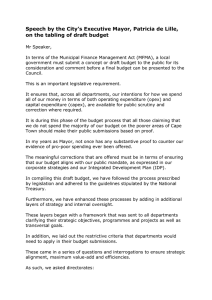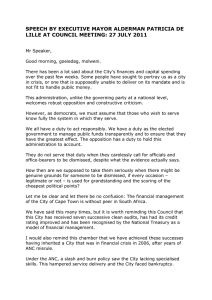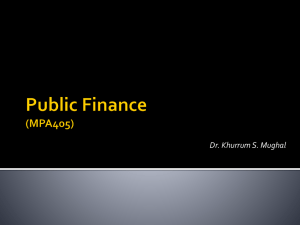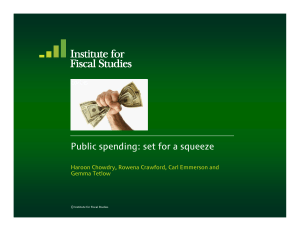ColmMcCarthy
advertisement
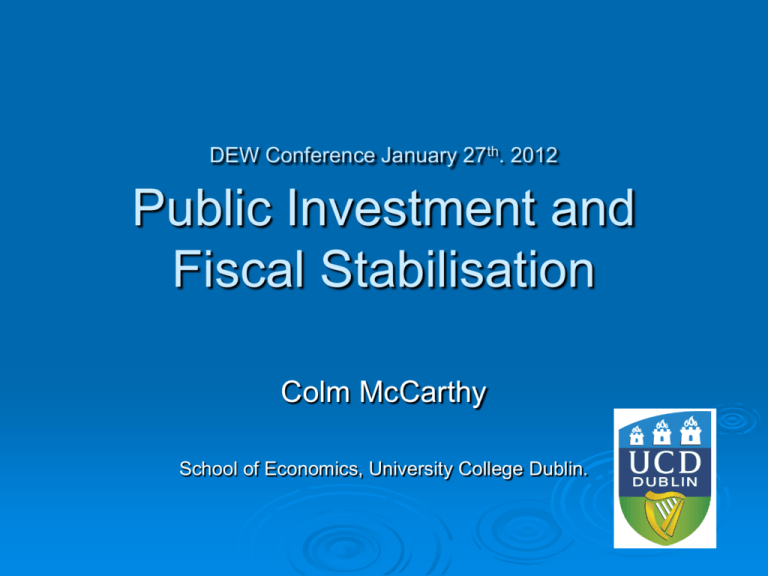
DEW Conference January 27th. 2012 Public Investment and Fiscal Stabilisation Colm McCarthy School of Economics, University College Dublin. A Popular Narrative… Capital There spending has collapsed…. is an infrastructure deficit… Unemployment So is high… let’s increase capital spending. Real Capital Formation (incl housing) Most of the Fall is Housing… 2005 2006 2007 2008 2009 2010 GDFCF €m 43548 48311 48486 39430 25293 18024 - Dwellings 20509 22626 20056 14507 7497 4441 = Capex 23039 25685 28430 24923 17796 13633 GDFCF % GDP 26.6 27.1 25.5 21.9 15.7 Capex % GDP 14.1 14.4 15.0 13.8 11.1 11.6 -15.0 8.7 -5.4 Then and Now From the Capital Spending Review… ‘Over the past decade or so, some €70 billion has been invested in infrastructure and the productive sector. Judged by a range of measures, the quality and quantity of the country’s stock of infrastructure has been considerably augmented in recent years.’ (Public Expenditure and Reform) What Infrastructure Deficit? Ireland just got smaller… Capital Spending and Jobs Aside from house-building, Edgar Morgenroth has shown that capital spending is not labour intensive Nor is it suited to a countercyclical role big projects can have 10-year lead-times, even schools take four Projects are never ‘shovel-ready’ Panama Canal c.1910 Man with Shovel How Big is State Capital Spend? - State capital spending does not end with the Exchequer capital programme. - State companies have had sizeable capital budgets over the last decade - The PPP projects are off the balance sheet, so the Exchequer figure understates total State capital spending. UK Treasury Select Committee ‘The price of finance is significantly higher with a PFI. The financial cost of repaying the capital investment of PFI investors is therefore considerably greater than the equivalent repayment of direct government investment. We have not seen evidence to suggest that this inefficient method of financing has been offset by the perceived benefits of PFI from increased risk transfer. On the contrary there is evidence of the opposite.’ (August 2011) There has been a wasteful bubble in state capital expenditure Ennis-Athenry rail line cost €105 million, absorbs €3 million pa in operating losses, average 8 passengers per train. NPV = - €137 million (Goodbody 2005). Regional airports are closing. DKM 1999: ‘The next programme should not contain …grant aid… for regional airports.’ The Project Evaluation There should be ex-post studies on major projects. Enhanced scrutiny of capital spending and acquisitions by state companies. A review of Irish experience with PPP. A statutory base for evaluation and an end to political projects. The Fiscal Responsibility Bill The DoF released a revised circular in 2005 on project evaluation. principle all projects over €30 million are supposed to be subjected to a proper costbenefit analysis. In The political over-ride needs to be circumscribed in legislation. Statutory Project Review The fiscal responsibility act should place the 2005 circular in law. Project evaluations to be conducted by Department of Public Expenditure, independent of project promoters, published, tabled at Dail committee prior to consideration by government. This approach recommended by ESRI in 2003.








